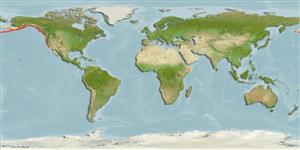>
Perciformes/Scorpaenoidei (Scorpionfishes) >
Sebastidae (Rockfishes, rockcods and thornyheads) > Sebastinae
Etymology: Sebastes: Greek, sebastes = august, venerable (Ref. 45335); melanops: From the Greek melas and ops meaning 'black' and 'face' (Ref. 27436).
More on author: Girard.
Environment: milieu / climate zone / depth range / distribution range
Ecologia
marinhas associadas(os) a recifes; intervalo de profundidade 0 - 366 m (Ref. 6885), usually 183 - 274 m (Ref. 6885). Temperate; 7°C - 9°C (Ref. 131065); 62°N - 22°N, 170°E - 110°W
Eastern Pacific: Amchitka Island, Aleutian Islands, Alaska to Paradise Cove, Baja California, Mexico.
Length at first maturity / Tamanho / Peso / Idade
Maturity: Lm 40.3, range 30 - 42 cm
Max length : 63.0 cm TL macho/indeterminado; (Ref. 27437); peso máx. Publicado: 4.8 kg (Ref. 2850); Idade máx. registada: 50 anos (Ref. 39247)
Descrição breve
Chaves de identificação | Morfologia | Morfometria
Espinhos dorsais (total) : 13 - 14; Raios dorsais moles (total) : 13 - 16; Espinhos anais: 3; Raios anais moles: 7 - 9; Vértebras: 26. Head spines weak to very weak - nasals present, preocular and postocular spines usually absent, supraocular, tympanic, coronal, parietal and nuchal spines absent (Ref. 27437). Symphyseal knob very weak or absent (Ref. 27437). Eyes moderately large (Ref. 27437). Anal fin profile rounded or with greater portion slanted posteriorly (Ref. 27437). Posterior margin of caudal fin indented (Ref. 27437). Dark grey to black with light grey mottling dorsally, lighter ventrally (Ref. 27437). Branchiostegal rays: 7 (Ref. 36715).
Found near rocky reefs in shallow water and in open water over deep banks (Ref. 2850). Adults live both off and on bottom (Ref. 2850). Juveniles are pelagic (Ref. 36715). Form schools (Ref. 2850). Feed on fishes (Ref. 27302). Viviparous, with planktonic larvae (Ref. 36715). Young are important prey species for other fishes, marine mammals and birds. Excellent food fish (Ref. 27436).
Eschmeyer, W.N., E.S. Herald and H. Hammann, 1983. A field guide to Pacific coast fishes of North America. Boston (MA, USA): Houghton Mifflin Company. xii+336 p. (Ref. 2850)
Categoria na Lista Vermelha da IUCN (Ref. 130435: Version 2024-1)
Ameaça para o homem
Harmless
Utilização humana
Pescarias: pouco comercial; peixe desportivo: sim; Aquário: Aquários públicos
Ferramentas
Relatórios especiais
Descarregue XML
Fontes da internet
Estimates based on models
Preferred temperature (Ref.
123201): 3.8 - 7.8, mean 5.5 °C (based on 52 cells).
Phylogenetic diversity index (Ref.
82804): PD
50 = 0.5000 [Uniqueness, from 0.5 = low to 2.0 = high].
Bayesian length-weight: a=0.01000 (0.00495 - 0.02022), b=3.09 (2.92 - 3.26), in cm total length, based on LWR estimates for this Genus-body shape (Ref.
93245).
Nível Trófico (Ref.
69278): 4.4 ±0.0 se; based on diet studies.
Resiliência (Ref.
120179): Baixo, tempo mínimo de duplicação da população 4,5 - 14 anos (tm=7.5; K=0.14; tmax=50).
Prior r = 0.18, 95% CL = 0.12 - 0.27, Based on 5 full stock assessments.
Fishing Vulnerability (Ref.
59153): High vulnerability (64 of 100).
Climate Vulnerability (Ref.
125649): Moderate vulnerability (37 of 100).
Nutrients (Ref.
124155): Calcium = 6.07 [2.24, 17.66] mg/100g; Iron = 0.114 [0.045, 0.266] mg/100g; Protein = 18.9 [17.8, 20.2] %; Omega3 = 0.774 [0.291, 2.159] g/100g; Selenium = 25.3 [9.1, 74.1] μg/100g; VitaminA = 96.4 [29.4, 326.0] μg/100g; Zinc = 0.322 [0.164, 0.589] mg/100g (wet weight); based on
nutrient studies.
